A Geochemical and Sr–Nd–Hf–O Isotopic Study of the Early Silurian Shandan Adakites in the Longshoushan Area: Implications for the Collisional Setting of the Proto–Tethyan North Qilian Orogen, Northwest China
Abstract
1. Introduction
2. Geological Setting
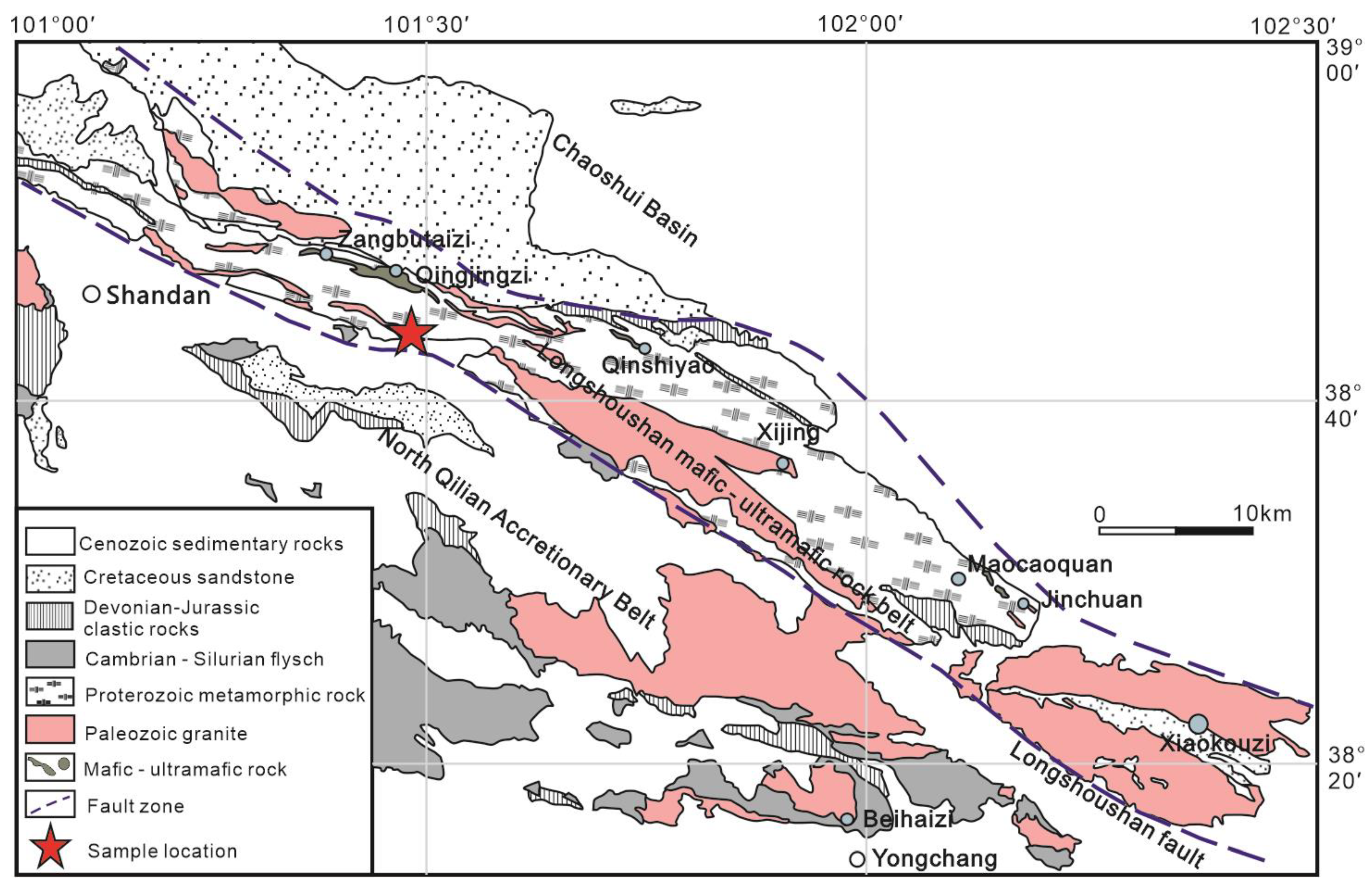
3. Analytical Methods
3.1. Zircon U–Pb Dating and Hf–O Isotopes
3.2. Whole-Rock Data
4. Results
4.1. Petrography
4.2. Zircon U–Pb Geochronology and Hf–O Isotopic Compositions
4.3. Whole-Rock Major and Trace Elements
4.4. Whole-Rock Sr–Nd Isotopic Compositions
5. Discussion
5.1. Petrogenesis

5.2. Mantle Source
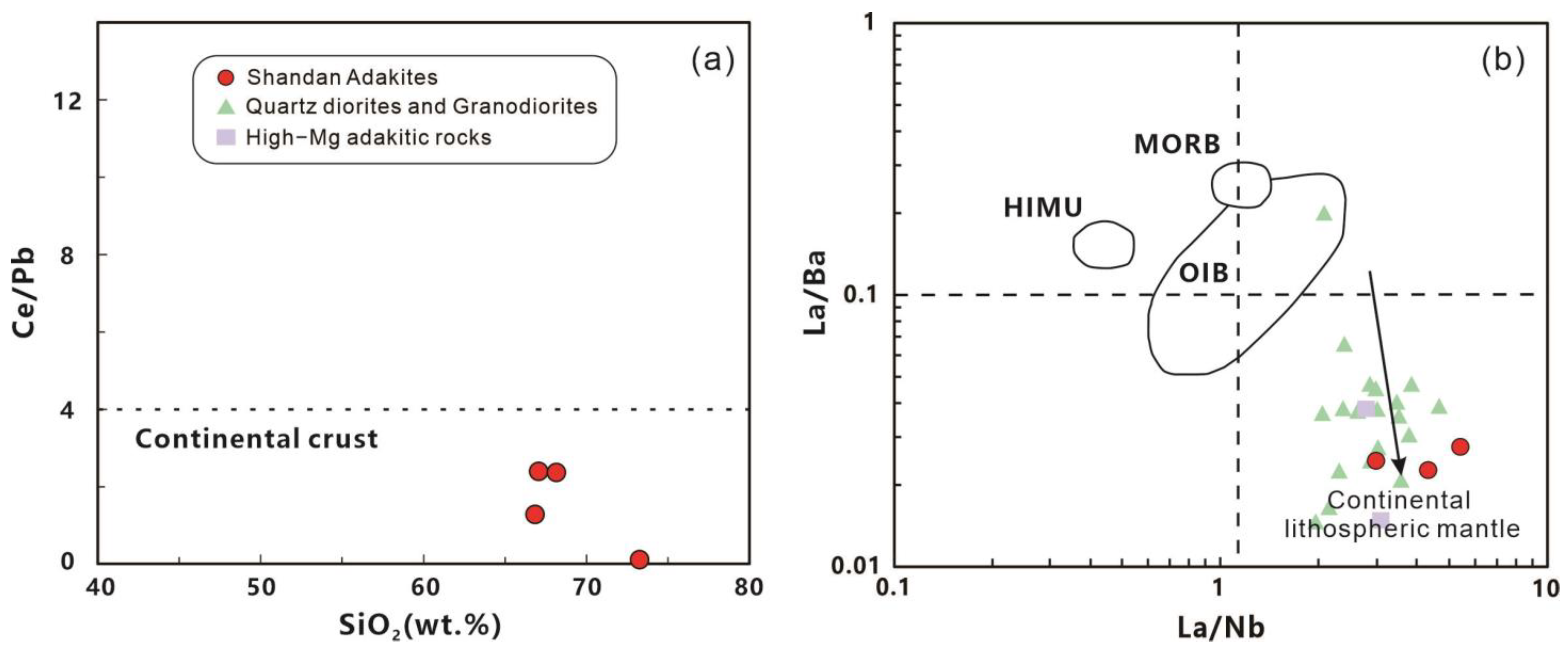
5.3. Geodynamic Processes
6. Conclusions
- The Shandan adakites were formed during the collisional to early post-collisional stages between the Alxa and Qilian blocks following the closure of the Proto-Tethyan North Qilian Ocean at ca. 446–440 Ma. The adakites have high Sr/Y (40.9–117) ratios and specific geochemical characteristics, revealing that their genesis is related to the partial melting of the mafic lower crust.
- The relatively enriched εHf(t) (3.30 to –12.4) and δ18O (5.34‰–7.52‰) of the Shandan adakites indicate that they were formed by the melting of the thickened lower crust and facilitated by mantle-derived heat input, which was accompanied by significant crust–mantle interaction.
- The Alxa and Central Qilian blocks then collided, which caused lower-crustal thickening and a transition to post-collisional tectonics after ca. 440 Ma.
Supplementary Materials
Author Contributions
Funding
Data Availability Statement
Acknowledgments
Conflicts of Interest
References
- Castillo, P.R. An overview of adakite petrogenesis. Chin. Sci. Bull. 2006, 51, 257–268. [Google Scholar] [CrossRef]
- Castillo, P.R. Adakite petrogenesis. Lithos 2012, 134, 304–316. [Google Scholar] [CrossRef]
- Rapp, R.; Shimizu, N.; Norman, M.; Applegate, G. Reaction between slab-derived melts and peridotite in the mantle wedge: Experimental constraints at 3.8 GPa. Chem. Geol. 1999, 160, 335–356. [Google Scholar] [CrossRef]
- Carmichael, I.S. The andesite aqueduct: Perspectives on the evolution of intermediate magmatism in west-central (105–199 W) Mexico. Contrib. Mineral. Petrol. 2002, 143, 641–663. [Google Scholar] [CrossRef]
- Martin, H.; Smithies, R.; Rapp, R.; Moyen, J.-F.; Champion, D. An overview of adakite, tonalite–trondhjemite–granodiorite (TTG), and sanukitoid: Relationships and some implications for crustal evolution. Lithos 2005, 79, 1–24. [Google Scholar] [CrossRef]
- Macpherson, C.G.; Dreher, S.T.; Thirlwall, M.F. Adakites without slab melting: High pressure differentiation of island arc magma, Mindanao, the Philippines. Earth Planet. Sci. Lett. 2006, 243, 581–593. [Google Scholar] [CrossRef]
- Tang, G.; Wang, Q.; Wyman, D.A.; Li, Z.-X.; Zhao, Z.-H.; Jia, X.-H.; Jiang, Z.-Q. Ridge subduction and crustal growth in the Central Asian Orogenic Belt: Evidence from Late Carboniferous adakites and high-Mg diorites in the western Junggar region, northern Xinjiang (west China). Chem. Geol. 2010, 277, 281–300. [Google Scholar] [CrossRef]
- Chung, S.-L.; Chu, M.-F.; Zhang, Y.; Xie, Y.; Lo, C.-H.; Lee, T.-Y.; Lan, C.-Y.; Li, X.; Zhang, Q.; Wang, Y. Tibetan tectonic evolution inferred from spatial and temporal variations in post-collisional magmatism. Earth Sci. Rev. 2005, 68, 173–196. [Google Scholar] [CrossRef]
- Wang, Q.; McDermott, F.; Xu, J.-f.; Bellon, H.; Zhu, Y.-t. Cenozoic K-rich adakitic volcanic rocks in the Hohxil area, northern Tibet: Lower-crustal melting in an intracontinental setting. Geology 2005, 33, 465–468. [Google Scholar] [CrossRef]
- Atherton, M.P.; Petford, N. Generation of sodium-rich magmas from newly underplated basaltic crust. Nature 1993, 362, 144–146. [Google Scholar] [CrossRef]
- Petford, N.; Atherton, M. Na-rich partial melts from newly underplated basaltic crust: The Cordillera Blanca Batholith, Peru. J. Petrol. 1996, 37, 1491–1521. [Google Scholar] [CrossRef]
- Condie, K.C. TTGs and adakites: Are they both slab melts? Lithos 2005, 80, 33–44. [Google Scholar] [CrossRef]
- Xu, J.-F.; Shinjo, R.; Defant, M.J.; Wang, Q.; Rapp, R.P. Origin of Mesozoic adakitic intrusive rocks in the Ningzhen area of east China: Partial melting of delaminated lower continental crust? Geology 2002, 30, 1111–1114. [Google Scholar]
- Kay, R.W.; Kay, S.M. Delamination and delamination magmatism. Tectonophysics 1993, 219, 177–189. [Google Scholar] [CrossRef]
- Rudnick, R.L. Making continental crust. Nature 1995, 378, 571–578. [Google Scholar] [CrossRef]
- Wang, Q.; Wyman, D.A.; Xu, J.; Dong, Y.; Vasconcelos, P.M.; Pearson, N.; Wan, Y.; Dong, H.; Li, C.; Yu, Y. Eocene melting of subducting continental crust and early uplifting of central Tibet: Evidence from central-western Qiangtang high-K calc-alkaline andesites, dacites and rhyolites. Earth Planet. Sci. Lett. 2008, 272, 158–171. [Google Scholar] [CrossRef]
- Xu, Z.-Q.; Yang, J.-S.; Li, H.-B.; Yao, J.-X. The Early Palaeozoic Terrene Framework and the Formation of the High-Pressure (HP) and Ultra-High Pressure (UHP) Metamorphic Belts at the Central Orogenic Belt (COB). Acta Geol. Sin. 2006, 80, 1793–1806. [Google Scholar]
- Song, S.; Niu, Y.; Su, L.; Xia, X. Tectonics of the north Qilian orogen, NW China. Gondwana Res. 2013, 23, 1378–1401. [Google Scholar] [CrossRef]
- Xia, L.-Q.; Li, X.-M.; Yu, J.-Y.; Wang, G.-Q. Mid−Late Neoproterozoic to Early Paleozoic volcanism and tectonic evolution of the Qilian Mountain. Geol. China 2016, 43, 1087–1138. [Google Scholar] [CrossRef]
- Dong, Y.; Sun, S.; Santosh, M.; Zhao, J.; Sun, J.; He, D.; Shi, X.; Hui, B.; Cheng, C.; Zhang, G. Central China orogenic belt and amalgamation of East Asian continents. Gondwana Res. 2021, 100, 131–194. [Google Scholar] [CrossRef]
- Xia, L.-Q.; Li, X.-M.; Yu, J.-Y.; Wang, G.-Q. Mid-late neoproterozoic to early paleozoic volcanism and tectonic evolution of the Qilianshan, NW China. GeoResJ 2016, 9–12, 1–41. [Google Scholar] [CrossRef]
- Wang, Z.-Z.; Chen, X.-H.; Shao, Z.-G.; Li, B.; Ding, W.-C.; Zhang, Y.-P.; Wang, Y.-C.; Zhang, Y.-Y.; Xu, S.-L.; Qin, X. Petrogenesis of the Late Silurian-Early Devonian granites in the Longshoushan-Helishan area, Gansu Province, and its tectonic implications for the Early Paleozoic evolution of the southwestern Alxa Block. Acta Geol. Sin. 2020, 94, 2243–2261. [Google Scholar] [CrossRef]
- Zhang, L.; Zhang, H.; Zhang, S.; Xiong, Z.; Luo, B.; Yang, H.; Pan, F.; Zhou, X.; Xu, W.; Guo, L. Lithospheric delamination in post-collisional setting: Evidence from intrusive magmatism from the North Qilian orogen to southern margin of the Alxa block, NW China. Lithos 2017, 288–289, 20–34. [Google Scholar] [CrossRef]
- Hu, N.; Xu, A.; Yang, J. Characteristics and tectonic environment of Zhigoumen pluton in Longshoushan area. J. Earth Sci. Environ. 2005, 27, 5–11. [Google Scholar]
- Zhang, J.; Meng, F.; Wan, Y. A cold Early Palaeozoic subduction zone in the North Qilian Mountains, NW China: Petrological and U-Pb geochronological constraints. J. Metamorph. Geol. 2007, 25, 285–304. [Google Scholar] [CrossRef]
- Liou, J.; Wang, X.; Coleman, R.G.; Zhang, Z.M.; Maruyama, S. Blueschists in major suture zones of China. Tectonics 1989, 8, 609–619. [Google Scholar] [CrossRef]
- Liu, Y.J.; Neubauer, F.; Genser, J.; Takasu, A.; Ge, X.H.; Handler, R. 40Ar/39Ar ages of blueschist facies pelitic schists from Qingshuigou in the Northern Qilian Mountains, western China. Isl. Arc 2006, 15, 187–198. [Google Scholar] [CrossRef]
- Xia, X.; Song, S.; Niu, Y. Tholeiite–Boninite terrane in the North Qilian suture zone: Implications for subduction initiation and back-arc basin development. Chem. Geol. 2012, 328, 259–277. [Google Scholar] [CrossRef]
- Tseng, C.-Y.; Yang, H.-J.; Yang, H.-Y.; Liu, D.; Tsai, C.-L.; Wu, H.; Zuo, G. The Dongcaohe ophiolite from the North Qilian Mountains: A fossil oceanic crust of the Paleo-Qilian ocean. Chin. Sci. Bull. 2007, 52, 2390–2401. [Google Scholar] [CrossRef]
- Qian, W.; Xilin, Z.; Yuanku, M.; Shengyao, Y.; Yanan, L. Early Devonian Post-collisional Granitic Magmatism in the North Qilian Orogenic Belt, Western China: Insights into Lithospheric Delamination and Orogenic Collapse. Acta Geol. Sin. 2024, 98, 352–367. [Google Scholar] [CrossRef]
- Liu, W.-H.; Pan, J.-Y.; Liu, X.-D.; Wang, K.-X.; Wang, G.; Xue, P. Petrogenesis and tectonic implication of Qingshanbao pluton in longshou moutains, gansu: Constraints from elemental geochemistry, zircon U-Pb age and Sr-Nd isotopes. Miner. Pet. 2019, 39, 26–40. [Google Scholar]
- Sun, B.-L.; Qian, Q.; Zhang, J.-X. Zircon U-Pb geochronology, Hf-O isotopes, whole-rock geochemistry of the Dafosi and Jinfosi granite plutons, Gansu Province and geological implications. Acta Petrol. Sin. 2017, 33, 3091–3108, (In Chinese with English Abstract). [Google Scholar]
- Leng, T.-C.; Liu, W.-H.; Yu, C.-D.; Liu, X.-D.; Wang, W.; Li, Y.-X. Discussion on Geochemical Characteristics and Genesis of Hongshiquan Syenite in Longshoushan Area, Gansu Province. Mineral. Petrol. 2021, 41, 72–83. [Google Scholar] [CrossRef]
- Niu, Y.-B.; Liu, W.-H.; Liu, X.-D.; Wang, K.-X.; Wang, G. Geochemistry and petrogenesis of Qingshanbao pluton of Longshoushan metallogenic belt in Gansu. Sci. Technol. Eng. 2018, 18, 11–21, (In Chinese with English Abstract). [Google Scholar]
- Yi, C.; ShuGuang, S. Deformation and metamorphism of HP belt in the North Qilian Mountains and their implications for exhumation. Acta Petrol. Sin. 2009, 25, 2235–2246. [Google Scholar]
- Xu, Y.-J.; Du, Y.-S.; Cawood, P.A.; Guo, H.; Huang, H.; An, Z.-H. Detrital zircon record of continental collision: Assembly of the Qilian Orogen, China. Sediment. Geol. 2010, 230, 35–45. [Google Scholar] [CrossRef]
- Zhao, X.; Liu, C.; Wang, J.; Zhao, Y.; Wang, L.; Zhang, Q. Detrital zircon U–Pb ages of Paleozoic sedimentary rocks from the eastern Hexi Corridor Belt (NW China): Provenance and geodynamic implications. Sediment. Geol. 2016, 339, 32–45. [Google Scholar] [CrossRef]
- Wang, K.-X.; Yu, C.-D.; Yan, J.; Liu, X.-D.; Liu, W.-H.; Pan, J.-Y. Petrogenesis of Early Silurian granitoids in the Longshoushan area and their implications for the extensional environment of the North Qilian Orogenic Belt, China. Lithos 2019, 342–343, 152–174. [Google Scholar] [CrossRef]
- Xue, F.; Yang, F.; Ren, W.; Santosh, M.; Qian, Z.; Huang, Y.; Tan, Z. Petrogenesis of the Early Paleozoic Dioritic–Granitic Magmatism in the Eastern North Qilian Orogen, NW China: Implications for Tethyan Tectonic Evolution. Lithosphere 2024, 2024, lithosphere_2023_2297. [Google Scholar] [CrossRef]
- Cox, K.G. Continental magmatic underplating. Philosophical Transactions of the Royal Society of London. Ser. A Phys. Eng. Sci. 1993, 342, 155–166. [Google Scholar] [CrossRef]
- Bryan, S.E.; Ferrari, L.; Reiners, P.W.; Allen, C.M.; Petrone, C.M.; Ramos-Rosique, A.; Campbell, I.H. New insights into crustal contributions to large-volume rhyolite generation in the mid-Tertiary Sierra Madre Occidental province, Mexico, revealed by U–Pb geochronology. J. Petrol. 2008, 49, 47–77. [Google Scholar] [CrossRef]
- Tang, Z.-L.; Bai, Y.-L. Geotectonic framework and metallogenic system in the southwest margin of North China paleocontinent. Earth Sci. Front. 1999, 78–90. [Google Scholar]
- Gong, J.; Zhang, J.; Wang, Z.; Yu, S.; Li, H.; Li, Y. Origin of the Alxa Block, western China: New evidence from zircon U–Pb geochronology and Hf isotopes of the Longshoushan Complex. Gondwana Res. 2016, 36, 359–375. [Google Scholar] [CrossRef]
- Xue, S.; Ling, M.-X.; Liu, Y.-L.; Zhang, H.; Sun, W. The genesis of early Carboniferous adakitic rocks at the southern margin of the Alxa Block, North China. Lithos 2017, 278–281, 181–194. [Google Scholar] [CrossRef]
- Liu, J.; Yin, C.; Zhang, J.; Qian, J.; Li, S.; Xu, K.; Wu, S.; Xia, Y. Tectonic evolution of the Alxa Block and its affinity: Evidence from the U-Pb geochronology and Lu-Hf isotopes of detrital zircons from the Longshoushan Belt. Precambr. Res. 2020, 344, 105733. [Google Scholar] [CrossRef]
- Gong, J.-H.; Zhang, J.-X.; Yu, S.-Y. The origin of Longshoushan Group and associated rocks in the southern part of the Alxa block: Constraint from LA-ICP-MS U-Pb zircon dating. Acta Petrol. Mineral. 2011, 30, 795–818. [Google Scholar]
- Tung, K.; Yang, H.; Liu, D.; Zhang, J.; Tseng, C.; Wan, Y. SHRIMP U-Pb geochronology of the detrital zircons from the Longshoushan Group and its tectonic significance. Chin. Sci. Bull. 2007, 52, 1414–1425. [Google Scholar] [CrossRef]
- Duan, J.; Li, C.; Qian, Z.; Jiao, J. Geochronological and geochemical constraints on the petrogenesis and tectonic significance of Paleozoic dolerite dykes in the southern margin of Alxa Block, North China Craton. J. Asian Earth Sci. 2015, 111, 244–253. [Google Scholar] [CrossRef]
- Liu, Y.; Hu, Z.; Gao, S.; Günther, D.; Xu, J.; Gao, C.; Chen, H. In situ analysis of major and trace elements of anhydrous minerals by LA-ICP-MS without applying an internal standard. Chem. Geol. 2008, 257, 34–43. [Google Scholar] [CrossRef]
- Ludwig, K. A geochronological toolkit for Microsoft Excel. Isoplot 2003, 3, 1–70. [Google Scholar]
- Li, X.; Li, W.; Wang, X.; Li, Q.; Liu, Y.; Tang, G. Role of mantle-derived magma in genesis of early Yanshanian granites in the Nanling Range, South China: In situ zircon Hf-O isotopic constraints. Sci. China Ser. D Earth Sci. 2009, 52, 1262–1278. [Google Scholar] [CrossRef]
- Yang, Q.; Xia, X.; Zhang, W.; Zhang, Y.; Xiong, B.; Xu, Y.; Wang, Q.; Wei, G. An evaluation of precision and accuracy of SIMS oxygen isotope analysis. Solid Earth Sci. 2018, 3, 81–86. [Google Scholar] [CrossRef]
- Baertschi, P. Absolute18O content of standard mean ocean water. Earth Planet. Sci. Lett. 1976, 31, 341–344. [Google Scholar] [CrossRef]
- Li, X.H.; Long, W.G.; Li, Q.L.; Liu, Y.; Zheng, Y.F.; Yang, Y.H.; Chamberlain, K.R.; Wan, D.F.; Guo, C.H.; Wang, X.C. Penglai zircon megacrysts: A potential new working reference material for microbeam determination of Hf–O isotopes and U–Pb age. Geostand. Geoanal. Res. 2010, 34, 117–134. [Google Scholar] [CrossRef]
- Li, X.; Tang, G.; Gong, B.; Yang, Y.; Hou, K.; Hu, Z.; Li, Q.; Liu, Y.; Li, W. Qinghu zircon: A working reference for microbeam analysis of U-Pb age and Hf and O isotopes. Chin. Sci. Bull. 2013, 58, 4647–4654. [Google Scholar] [CrossRef]
- Xijun, L.; Ji-Feng, X.; Castillo, P.R.; Wenjiao, X.; Yu, S.; Zhiguo, Z.; Xuan-Ce, W.; Songjian, A.; Baohua, W.; Rongguo, H.; et al. Long-lived low Th/U Pacific-type isotopic mantle domain: Constraints from Nd and Pb isotopes of the Paleo-Asian Ocean mantle. Earth Planet. Sci. Lett. 2021, 567, 117006. [Google Scholar] [CrossRef]
- Zhang, Z.; Liu, X.; Xiao, W.; Xu, J.-F.; Shi, Y.; Gong, X.; Hu, R.; Liu, P.; Song, Y.; Xiao, Y. Geochemistry and Sr–Nd–Hf–Pb isotope systematics of late Carboniferous sanukitoids in northern West Junggar, NW China: Implications for initiation of ridge-subduction. Gondwana Res. 2021, 99, 204–218. [Google Scholar] [CrossRef]
- Hoskin, P.W.O.; Black, L.P. Metamorphic zircon formation by solid-state recrystallization of protolith igneous zircon. J. Metamorph. Geol. 2000, 18, 423–439. [Google Scholar] [CrossRef]
- Valley, J.W.; Kinny, P.D.; Schulze, D.J.; Spicuzza, M.J. Zircon megacrysts from kimberlite: Oxygen isotope variability among mantle melts. Contrib. Mineral. Petrol. 1998, 133, 1–11. [Google Scholar] [CrossRef]
- Sun, S.S.; McDonogh, W.F. Chemicalandisotopicsystematics ofoceanicbasalts: Implicationsfor mantlecompositionand processes. Geol. Lond. Spec. 1989, 42, 313–345. [Google Scholar]
- Yu, S.; Zhang, J.; Qin, H.; Sun, D.; Zhao, X.; Cong, F.; Li, Y. Petrogenesis of the early Paleozoic low-Mg and high-Mg adakitic rocks in the North Qilian orogenic belt, NW China: Implications for transition from crustal thickening to extension thinning. J. Asian Earth Sci. 2015, 107, 122–139. [Google Scholar] [CrossRef]
- Chen, Y.; Song, S.; Niu, Y.; Wei, C. Melting of continental crust during subduction initiation: A case study from the Chaidanuo peraluminous granite in the North Qilian suture zone. Geochim. Cosmochim. Acta 2014, 132, 311–336. [Google Scholar] [CrossRef]
- Yang, Y.-H.; Wu, F.-Y.; Wilde, S.A.; Liu, X.-M.; Zhang, Y.-B.; Xie, L.-W.; Yang, J.-H. In situ perovskite Sr–Nd isotopic constraints on the petrogenesis of the Ordovician Mengyin kimberlites in the North China Craton. Chem. Geol. 2009, 264, 24–42. [Google Scholar] [CrossRef]
- Johnson, K. Experimental cpx/and garnet/melt partitioning of REE and other trace elements at high pressures: Petrogenetic implications. Mineral. Mag. A 1994, 58, 454–455. [Google Scholar]
- Defant, M.J.; Drummond, M.S. Derivation of some modern arc magmas by melting of young subducted lithosphere. Nature 1990, 347, 662–665. [Google Scholar] [CrossRef]
- Chung, S.-L.; Liu, D.; Ji, J.; Chu, M.-F.; Lee, H.-Y.; Wen, D.-J.; Lo, C.-H.; Lee, T.-Y.; Qian, Q.; Zhang, Q. Adakites from continental collision zones: Melting of thickened lower crust beneath southern Tibet. Geology 2003, 31, 1021–1024. [Google Scholar] [CrossRef]
- Zhao, T.; Cawood, P.A.; Wang, K.; Zi, J.-W.; Feng, Q.; Nguyen, Q.M.; Tran, D.M. Neoarchean and Paleoproterozoic K-rich granites in the Phan Si Pan Complex, north Vietnam: Constraints on the early crustal evolution of the Yangtze Block. Precambrian Res. 2019, 332, 105395. [Google Scholar] [CrossRef]
- Wu, C.-L.; Yao, S.-Z.; Yang, J.-S.; Zeng, L.-S.; Chen, S.-Y.; Li, H.-B.; Qi, X.-X.; Wooden, J.L.; Mazdab, F.K. Double subduction of the Early Paleozoic North Qilian oceanic plate: Evidence from granites in the central segment of North Qilian, NW China. Geol. China 2006, 33, 1197–1208. [Google Scholar]
- Zhao, J.-L.; Huang, X.-J.; Hu, P.-Q.; Yang, Z.-X.; Fan, Y.; Wang, E.-T.; Yang, F.-B.; Zhang, J.-Y. Petrogenesis and tectonic implications of the Silurian adakitic granitoids in the eastern segment of the Qilian Orogenic Belt, Northwest China. Acta Geochim. 2024, 43, 72–86. [Google Scholar] [CrossRef]
- Zheng, Y.; Chen, Y.; Dai, L.; Zhao, Z. Developing plate tectonics theory from oceanic subduction zones to collisional orogens. Sci. China Earth Sci. 2015, 58, 1045–1069. [Google Scholar] [CrossRef]
- King, P.L.; White, A.; Chappell, B.; Allen, C. Characterization and origin of aluminous A-type granites from the Lachlan Fold Belt, southeastern Australia. J. Petrol. 1997, 38, 371–391. [Google Scholar] [CrossRef]
- Wang, Q.; Xu, J.-F.; Jian, P.; Bao, Z.-W.; Zhao, Z.-H.; Li, C.-F.; Xiong, X.-L.; Ma, J.-L. Petrogenesis of adakitic porphyries in an extensional tectonic setting, Dexing, South China: Implications for the genesis of porphyry copper mineralization. J. Petrol. 2006, 47, 119–144. [Google Scholar] [CrossRef]
- Belousova, E.; Griffin, W.; O’Reilly, S.Y. Zircon crystal morphology, trace element signatures and Hf isotope composition as a tool for petrogenetic modelling: Examples from Eastern Australian granitoids. J. Petrol. 2006, 47, 329–353. [Google Scholar] [CrossRef]
- Yang, J.-H.; Wu, F.-Y.; Wilde, S.A.; Xie, L.-W.; Yang, Y.-H.; Liu, X.-M. Tracing magma mixing in granite genesis: In situ U–Pb dating and Hf-isotope analysis of zircons. Contrib. Mineral. Petrol. 2007, 153, 177–190. [Google Scholar] [CrossRef]
- Rudnick, R.L.; Gao, S. Composition of the Continental Crust. Treatise Geochem. 2014, 4, 1–51. [Google Scholar]
- Thompson, P.M.; Kempton, P.D.; Kerr, A.C. Evaluation of the effects of alteration and leaching on Sm–Nd and Lu–Hf systematics in submarine mafic rocks. Lithos 2008, 104, 164–176. [Google Scholar] [CrossRef]
- Jahn, B.-m.; Wu, F.; Lo, C.-H.; Tsai, C.-H. Crust–mantle interaction induced by deep subduction of the continental crust: Geochemical and Sr–Nd isotopic evidence from post-collisional mafic–ultramafic intrusions of the northern Dabie complex, central China. Chem. Geol. 1999, 157, 119–146. [Google Scholar] [CrossRef]
- Workman, R.K.; Hart, S.R. Major and trace element composition of the depleted MORB mantle (DMM). Earth Planet. Sci. Lett. 2005, 231, 53–72. [Google Scholar] [CrossRef]
- Zindler, A.; Hart, S. Chemical geodynamics. Annu. Rev. Earth Planet. Sci. 1986, 14, 493–571. [Google Scholar]
- Gong, J.; Zhang, J.; Yu, S.; Li, H.; Hou, K. Ca. 2.5 Ga TTG rocks in the western Alxa Block and their implications. Chin. Sci. Bull. 2012, 57, 4064–4076. [Google Scholar] [CrossRef]
- Saunders, A.D.; Storey, M.; Kent, R.; Norry, M. Consequences of plume-lithosphere interactions. Geol. Soc. Lond. Spec. Publ. 1992, 68, 41–60. [Google Scholar] [CrossRef]
- Schmitz, M.D.; Vervoort, J.D.; Bowring, S.A.; Patchett, P.J. Decoupling of the Lu-Hf and Sm-Nd isotope systems during the evolution of granulitic lower crust beneath southern Africa. Geology 2004, 32, 405–408. [Google Scholar] [CrossRef]
- Amelin, Y.; Lee, D.-C.; Halliday, A.N.; Pidgeon, R.T. Nature of the Earth’s earliest crust from hafnium isotopes in single detrital zircons. Nature 1999, 399, 252–255. [Google Scholar] [CrossRef]
- Dewey, J.F. Extensional collapse of orogens. Tectonics 1988, 7, 1123–1139. [Google Scholar] [CrossRef]
- Zhang, J.; Yu, S.; Mattinson, C.G. Early Paleozoic polyphase metamorphism in northern Tibet, China. Gondwana Res. 2017, 41, 267–289. [Google Scholar] [CrossRef]
- Song, S.G.; Zhang, G.B.; Zhang, C.; Zhang, L.-F.; Wei, C.-J. Dynamic process of oceanic subduction and continental collision: Petrological constraints of HP-UHP belts in Qilian-Qaidam, the northern Tibetan Plateau. Chin. Sci. Bull. 2013, 58, 2240–2245. [Google Scholar] [CrossRef]
- Wei, Q.-Q.; Hao, L.-B.; Lu, J.-L.; Zhao, Y.-Y.; Zhao, X.-Y.; Shi, H.-L. LA-MC-ICP-MS Zircon U-Pb Dating of Hexipu granite and Its Geological Implications. Bull. Mineral. Petrol. Geochem. 2013, 32, 729–735, (In Chinese with English Abstract). [Google Scholar]
- Chen, Y.-J.; Wang, G.; Waang, W.; He, J.-J.; Li, X.-C.; Zhang, C.; Guo, B.-J. Geological Characteristics and Significance of Middle-coarse Grain Granites in Jiling Area of Longshoushan. Uranium Geol. 2022, 38, 1111–1121. [Google Scholar] [CrossRef]
- Chen, S.; Niu, Y.; Li, J.; Sun, W.; Zhang, Y.; Hu, Y.; Shao, F. Syn-collisional adakitic granodiorites formed by fractional crystallization: Insights from their enclosed mafic magmatic enclaves (MMEs) in the Qumushan pluton, North Qilian Orogen at the northern margin of the Tibetan Plateau. Lithos 2016, 248–251, 455–468. [Google Scholar] [CrossRef]
- Tseng, C.-Y.; Yang, H.-J.; Yang, H.-Y.; Liu, D.; Wu, C.; Cheng, C.-K.; Chen, C.-H.; Ker, C.-M. Continuity of the North Qilian and North Qinling orogenic belts, Central Orogenic System of China: Evidence from newly discovered Paleozoic adakitic rocks. Gondwana Res. 2009, 16, 285–293. [Google Scholar] [CrossRef]
- Tseng, C.-Y.; Zuo, G.-C.; Yang, H.-J.; Yang, H.-Y.; Tung, K.-A.; Liu, D.-Y.; Wu, H.-Q. Occurrence of Alaskan-type mafic-ultramafic intrusions in the North Qilian Mountains, northwest China: Evidence of Cambrian arc magmatism on the Qilian Block. Isl. Arc 2009, 18, 526–549. [Google Scholar] [CrossRef]
- Pearce, J. Sources and settings of granitic rocks. Epis. J. Int. Geosci. 1996, 19, 120–125. [Google Scholar] [CrossRef]
- Eby, G.N. Chemical subdivision of the A-type granitoids: Petrogenetic and tectonic implications. Geology 1992, 20, 641–644. [Google Scholar]
- Qiao, J.; Dong, J.; Song, S.; Allen, M.B.; Wang, C.; Xia, X.; Su, L. Development of a Modern-Style Trench-Arc-Backarc System in the Proto-Tethys Ocean (Qilian Orogenic Belt, NW China). J. Petrol. 2023, 64, egad029. [Google Scholar] [CrossRef]


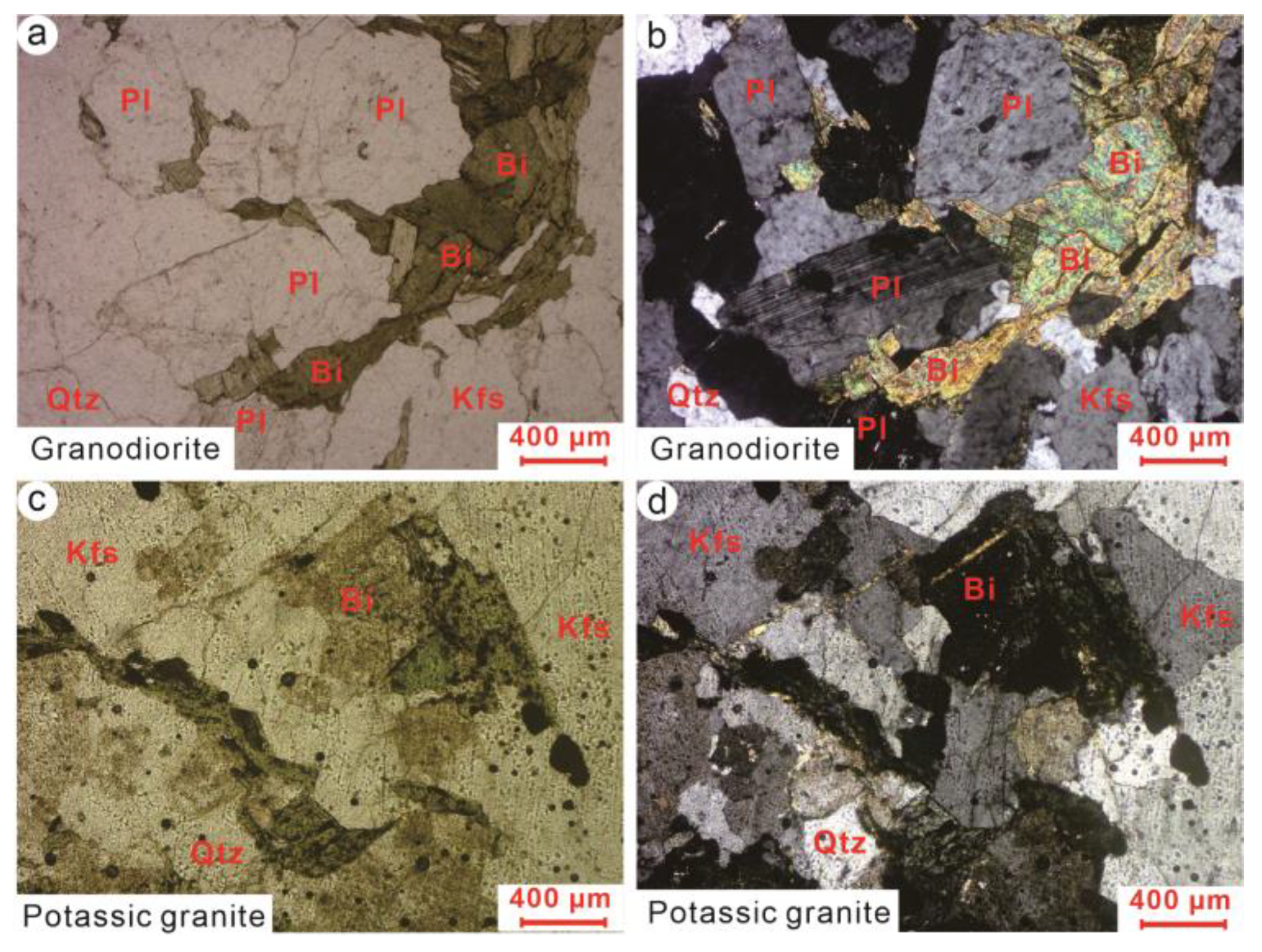

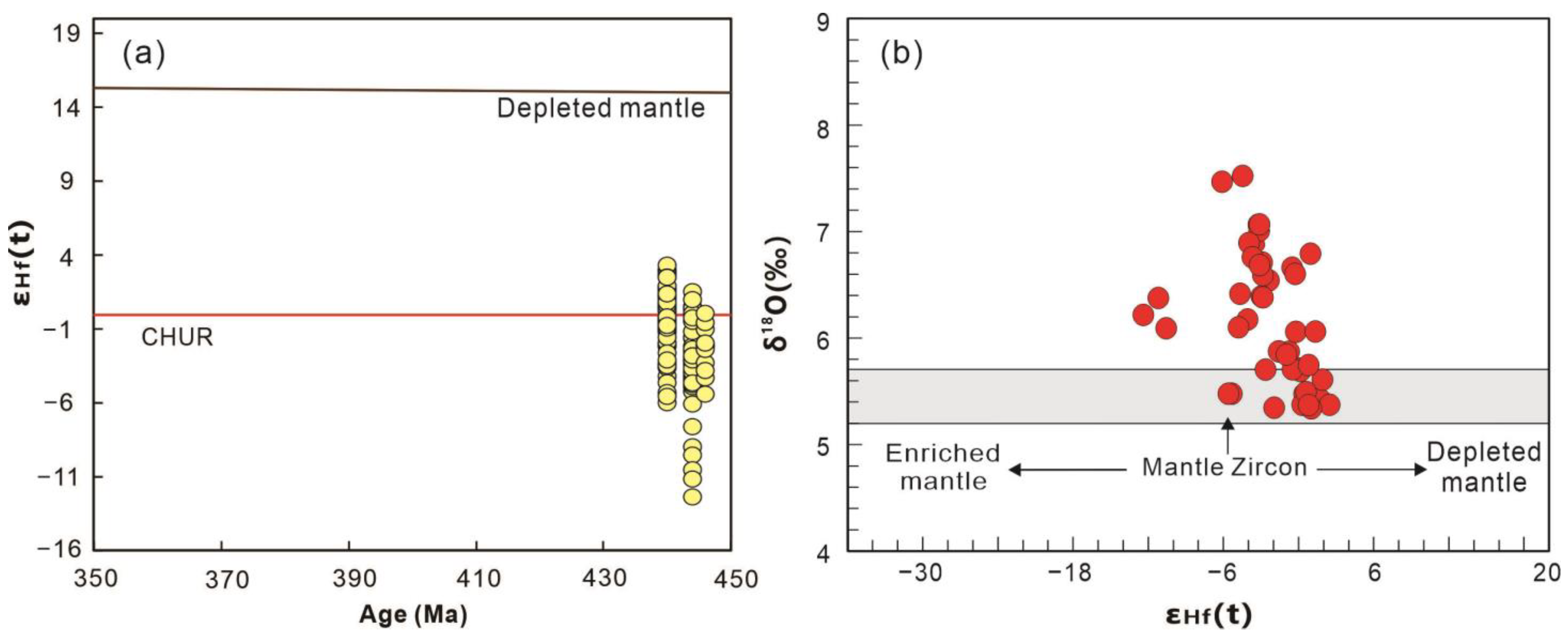
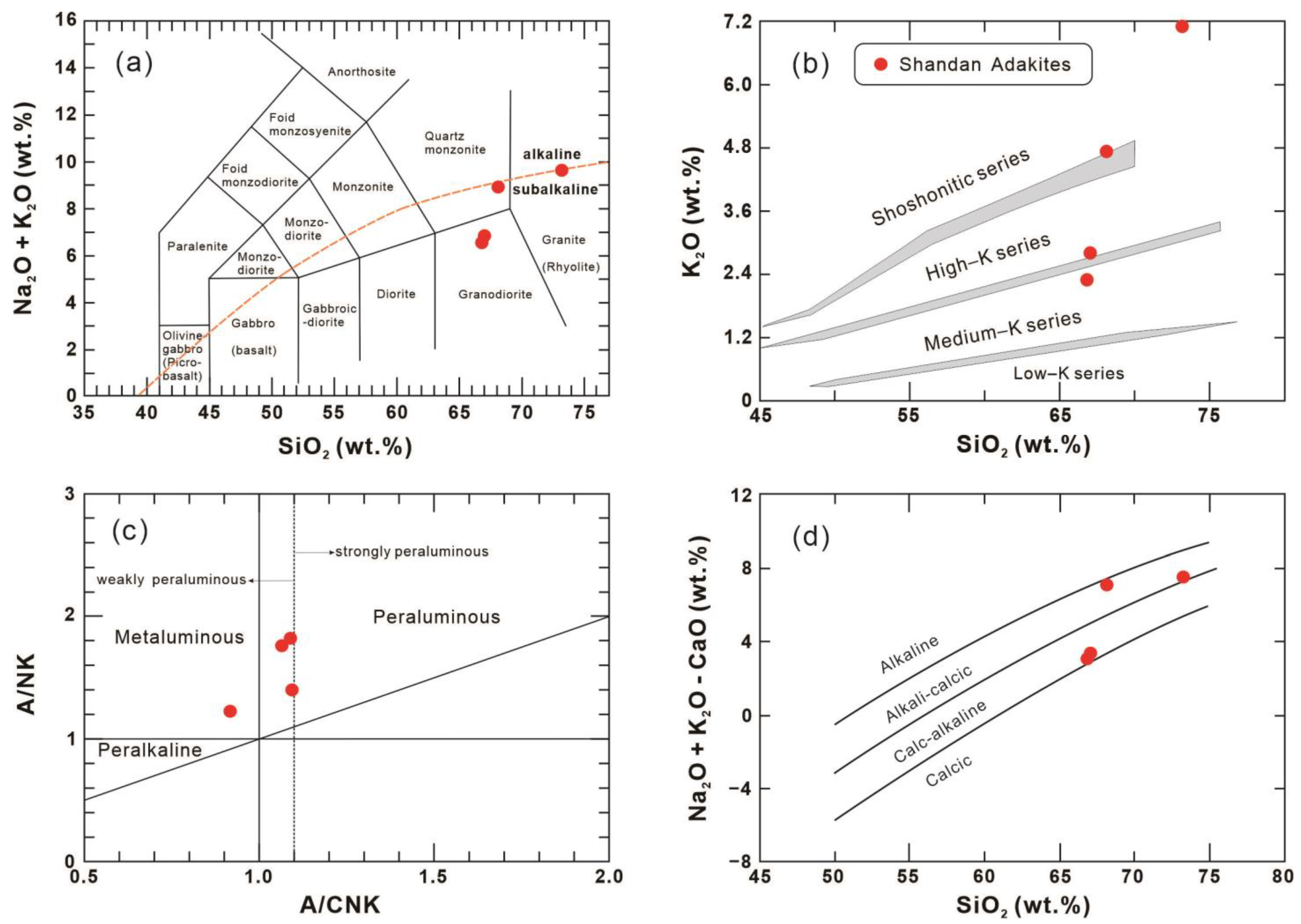

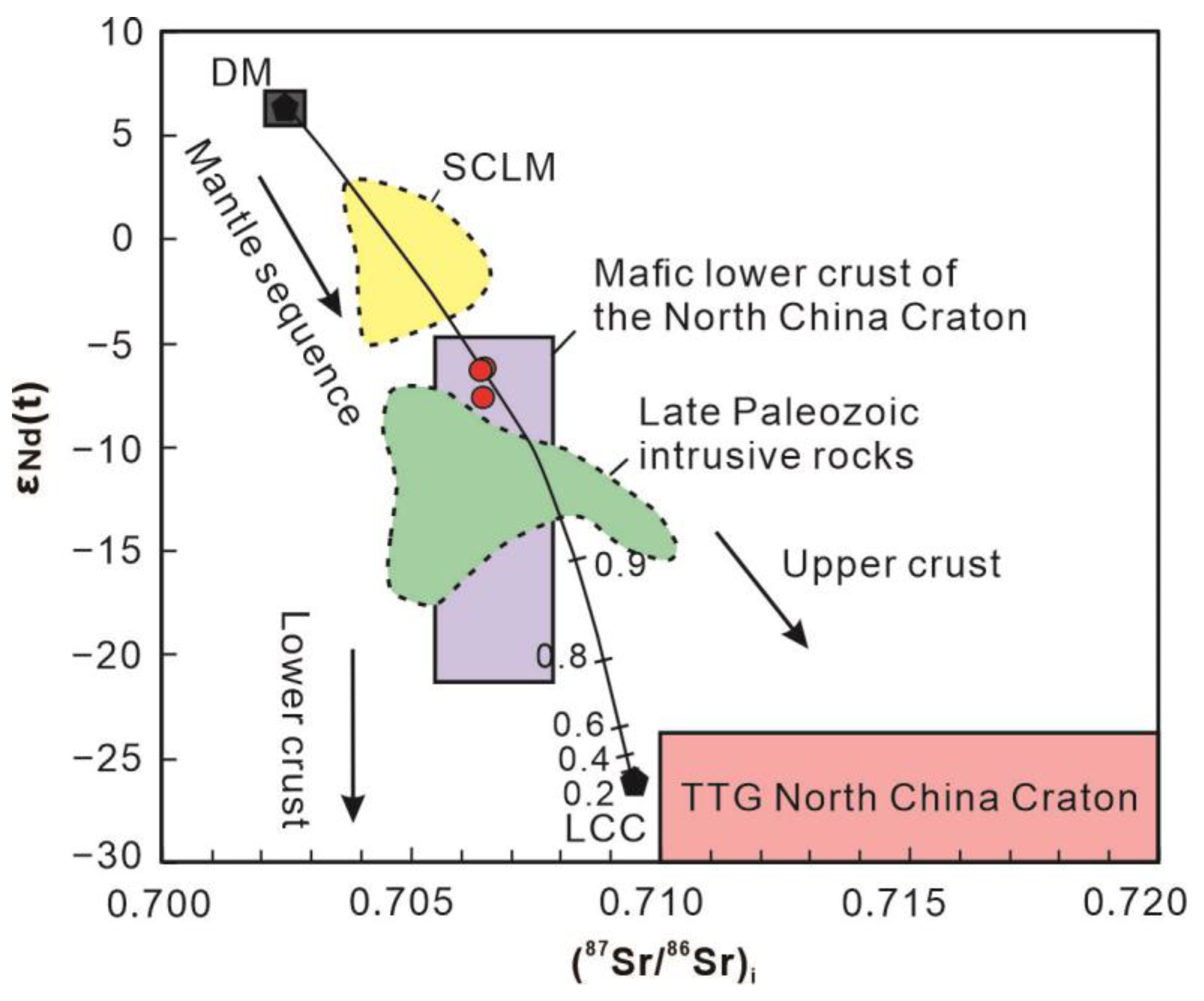

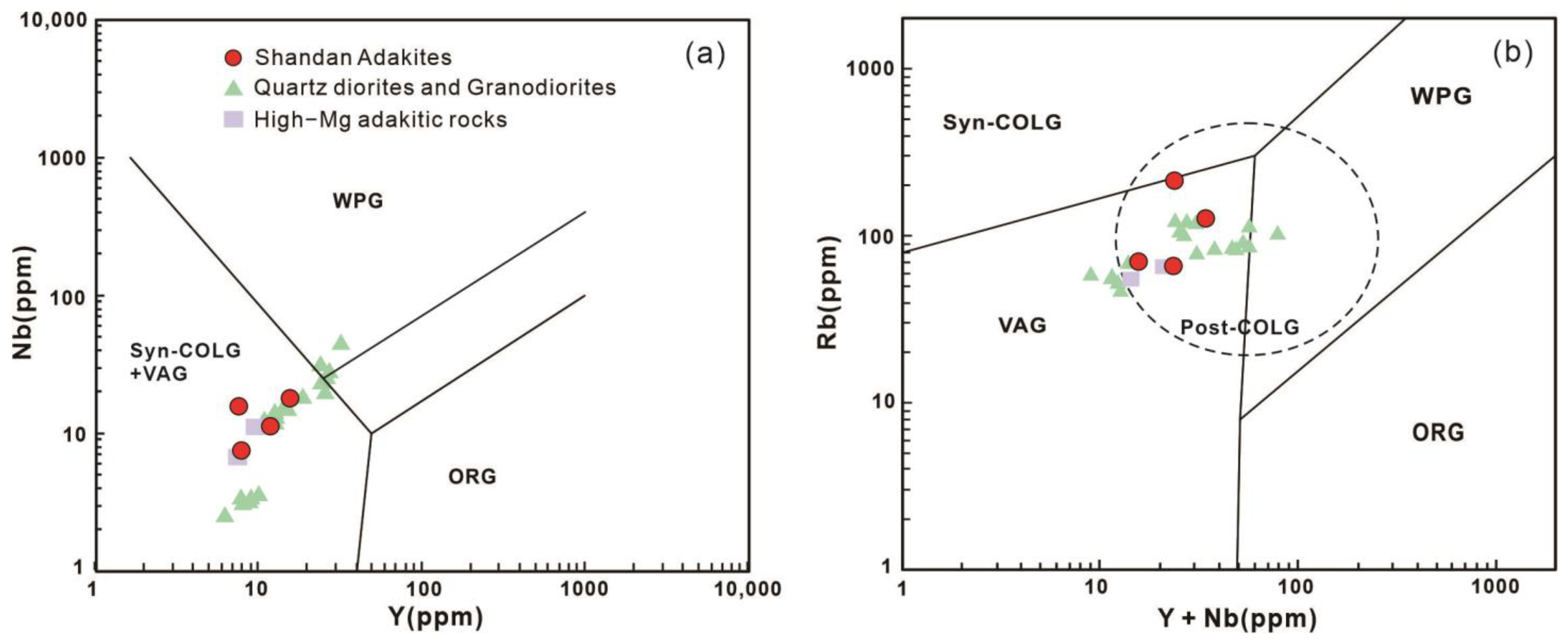
Disclaimer/Publisher’s Note: The statements, opinions and data contained in all publications are solely those of the individual author(s) and contributor(s) and not of MDPI and/or the editor(s). MDPI and/or the editor(s) disclaim responsibility for any injury to people or property resulting from any ideas, methods, instructions or products referred to in the content. |
© 2025 by the authors. Licensee MDPI, Basel, Switzerland. This article is an open access article distributed under the terms and conditions of the Creative Commons Attribution (CC BY) license (https://creativecommons.org/licenses/by/4.0/).
Share and Cite
Bai, Z.; Yang, Y.; Liu, X.; Liu, P.; Chen, G.; Liu, X.; Hu, R.; Tian, H.; Liu, Y.; Huang, W.; et al. A Geochemical and Sr–Nd–Hf–O Isotopic Study of the Early Silurian Shandan Adakites in the Longshoushan Area: Implications for the Collisional Setting of the Proto–Tethyan North Qilian Orogen, Northwest China. Minerals 2025, 15, 352. https://doi.org/10.3390/min15040352
Bai Z, Yang Y, Liu X, Liu P, Chen G, Liu X, Hu R, Tian H, Liu Y, Huang W, et al. A Geochemical and Sr–Nd–Hf–O Isotopic Study of the Early Silurian Shandan Adakites in the Longshoushan Area: Implications for the Collisional Setting of the Proto–Tethyan North Qilian Orogen, Northwest China. Minerals. 2025; 15(4):352. https://doi.org/10.3390/min15040352
Chicago/Turabian StyleBai, Zhihan, Yang Yang, Xijun Liu, Pengde Liu, Gang Chen, Xiao Liu, Rongguo Hu, Hao Tian, Yande Liu, Wenmin Huang, and et al. 2025. "A Geochemical and Sr–Nd–Hf–O Isotopic Study of the Early Silurian Shandan Adakites in the Longshoushan Area: Implications for the Collisional Setting of the Proto–Tethyan North Qilian Orogen, Northwest China" Minerals 15, no. 4: 352. https://doi.org/10.3390/min15040352
APA StyleBai, Z., Yang, Y., Liu, X., Liu, P., Chen, G., Liu, X., Hu, R., Tian, H., Liu, Y., Huang, W., & Xiao, Y. (2025). A Geochemical and Sr–Nd–Hf–O Isotopic Study of the Early Silurian Shandan Adakites in the Longshoushan Area: Implications for the Collisional Setting of the Proto–Tethyan North Qilian Orogen, Northwest China. Minerals, 15(4), 352. https://doi.org/10.3390/min15040352









